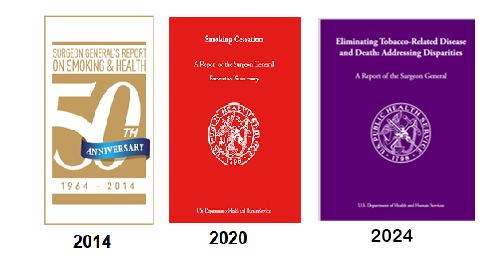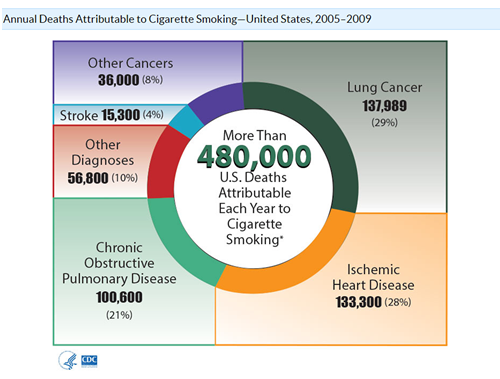Online Course
NRSG 780 - Health Promotion and Population Health
Module 2: Determinants of Health
Modifiable Lifestyle Risk Factors: Smoking
One modifiable lifestyle risk factor of the leading causes of death is smoking. This subtopic will focus on some of the evidence available on the effects of smoking and trends associated with it.
Ernst Wynder’s landmark studies date as far back as 1950, and described tobacco smoking as a possible factor in lung cancer. One of the earliest studies of 684 cases describes smoking as a possible etiologic factor in bronchiogenic carcinoma (1), and another study describes tobacco as a cause of lung cancer with special reference to the infrequency of lung cancer among non-smokers (2).
- Wynder, E.L. & Graham E.A. (1950). Tobacco smoking as a possible etiologic factor in bronchiogenic carcinoma: A study of 684 proved cases. Journal of the American Medical Association, 143(4), 329-36.
- Wynder, E.L. (1954). Tobacco as a cause of lung cancer with special reference to the infrequency of lung cancer among non-smokers. Pennsylvania Medical Journal, 57, 1073-1083.
The Surgeon General Office has been issuing reports on smoking since 1964. These reports reaffirm that cigarette smoking is the leading risk factor for premature death in our country.


Source: http://www.surgeongeneral.gov/priorities/tobacco/
Source: https://www.hhs.gov/sites/default/files/2024-sgr-tobacco-related-health-disparities-full-report.pdf
For more information, review the executive summary.
Risks of Smoking
Tobacco is responsible for over 20% of deaths in the U.S. and serves as a major contributor to deaths from cancer, heart disease, stroke, diseases of the lung and numerous other causes.

Source: 2014 Surgeon General's Report, Table 12.4, page 660
http://www.cdc.gov/tobacco/data_statistics/tables/health/infographics/index.htm
Evidence-based studies implicate smoking as a major risk factor for cancers, including:
- Lung cancer
- Bladder cancer
- Laryngealcancer
- Oral cancer
- Cervical cancer
- Pancreatic cancer
- Esophageal cancer
- Stomach cancer
- Kidney cancer
- Leukemia
Smoking is recognized as a leading risk factor for cardiovascular diseases including abdominal aortic aneurysm, atherosclerosis, cerebrovascular disease and coronary heart disease.
Smoking is implicated in a series of respiratory diseases including COPD, pneumonia, and respiratory effects in utero, childhood, adolescence and adulthood.
Smoking has been identified as a risk factor for reproductive problems including fetal deaths and stillbirths, impaired fertility, low birthweight and complications of pregnancy.
Other risks of smoking now include cataracts, low bone density and peptic ulcer disease. Smoking related illnesses in the U.S. cost more than $600 billion a year, including nearly $240 billion in direct medical care for adults and $1372 billion in lost productivity.
Source:CDC Burden of Cigarette Use in the U.S. (August 3, 2022) Available at https://www.cdc.gov/tobacco/campaign/tips/resources/data/cigarette-smoking-in-united-states.html?s_cid=OSH_tips_GL0005&utm_source=google&utm_medium=cpc&utm_campaign=TipsRegular+2021%3BS%3BWL%3BBR%3BIMM%3BDTC%3BCO&utm_content=Smoking+-+Facts_P&utm_term=facts+about+smoking&gclid=Cj0KCQjw08aYBhDlARIsAA_gb0dC-ZmCgkdjgeF9NK97xXB2eq9TxNFu4YzmAsTrGUiTgD0UtwCUohkaAgmDEALw_wcB&gclsrc=aw.ds
Trends in Cigarette Smoking
 Based on its well-documented negative health effects, information on tobacco use is part of the Behavioral Risk Factor Surveillance System.
Based on its well-documented negative health effects, information on tobacco use is part of the Behavioral Risk Factor Surveillance System.
Current data from the BRFSS indicates that there has been a modest decline in smoking during the past decade. In 2019, 15.3% of men and 12.7% of women % in the U.S. identified themselves as current smokers.

In 2020, 7.4% of young adults (18-24) and 9% of persons over 65 years smoke. Half of all adolescents that continue to smoke regularly will die eventually from a smoking-related illness.
In the U.S. smoking rates peak from 45-64 and then begins to decline
Questions:
Given the impact of smoking on health, should smoking cessation initiatives be a public health priority?
Can you identify barriers to community-based tobacco initiatives geared toward not starting or stopping smoking?
Should providers be more involved in trying to assist their patients stop smoking?
Can you identify barriers to providers addressing smoking cessation with their patients?
This website is maintained by the University of Maryland School of Nursing (UMSON) Office of Learning Technologies. The UMSON logo and all other contents of this website are the sole property of UMSON and may not be used for any purpose without prior written consent. Links to other websites do not constitute or imply an endorsement of those sites, their content, or their products and services. Please send comments, corrections, and link improvements to nrsonline@umaryland.edu.